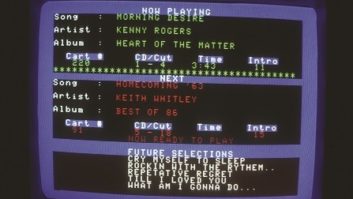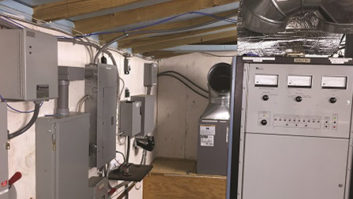Hammett & Edison’s Dane Ericksen, P.E., sends a note about the battery corrosion we discussed in the Oct. 19 Workbench (see Fig. 1). Dane adds: Don’t wait too long to check for corrosion and clean, because the rot may migrate along your wires. That almost happened to Dane’s treasured B&K Model 162 transistor tester. See Figs. 2 and 3.

Fig. 1: A solution of vinegar or baking soda, depending on battery type, will clean corrosion like this.

Fig. 2: Corrosion can migrate along insulated wire, rendering it useless.
As we’ve suggested, Dane now makes it a point to check his infrequently used and battery-powered electronics at least annually.

Fig. 3: Remove the wire insulation to see the damage caused by the corrosion.
You already replace your smoke detector batteries or “memory keep-alive” batteries once a year; add your portable test gear to avoid disappointment later. (That includes the DVM rolling around in your trunk!) The New Year is a good time to make this annual check.
Dane Ericksen is co-chair of the Engineers for the Integrity of Broadcast Auxiliary Services Spectrum (EIBASS) and serves on the SBE National Certification Committee. He’s also active with SBE Chapter 40, San Francisco.
* * *
I’ve received comments from readers upset at the diameter change discovered and described by Bob Meister in the Oct. 5 issue.
More than a few readers feel an almost religious attachment to the venerable “Greenie,” Xcelite’s R3322 screwdriver. I’m sure some of the originals can still be found. It’s probably time to turn to your search engines.
I located stock at both MCM Electronics and Newark through an Internet search.
* * *
(click thumbnail)
Fig. 4: A simple power supply test setup for a Broadcast Tools Switcher.

Engineer Frank Hertel of Hertel Engineering and Newman-Kees RF Measurements in Evansville, Ind., tells us he always looks forward to Workbench. Thanks Frank; I’m really glad you are getting information you can use from the column.
Frank prepared the attached schematic, shown in Fig. 4, and says it may be of use to readers wanting to do repairs or provide an emergency power source for their Broadcast Tools ACS8.2 Plus or SS8.2 Switcher.
Frank also passed on a neat WMV file from a company in Asia. It shows a unique drill bit that oscillates in various elliptical patterns to “drill” a square hole! The price is not listed — of course. But for those of us who painstakingly used a file and aluminum nibbler to cut holes for square switches, something like this would have saved a lot of time.
I’ve posted the video here: tinyurl.com/wbdrill.
* * *

Fig. 5: Secure a flashlight near your transmitter entrance — and don’t forget to check its batteries too.
Quick, do you know where your transmitter flashlight is right now? Would it work if you turned it on?
Good engineering practice: Use a spring clip to mount a flashlight near the door entry, as shown in Fig. 5. Remember to check that the batteries work and aren’t corroded.
Backup gear — whether it be a spare transmitter, a generator or a flashlight — is useful only if it works.
Contribute to Workbench. You’ll help your fellow engineers and qualify for SBE recertification credit. Send tips to [email protected]. Fax to (603) 472-4944.
Author John Bisset has spent 43 years in the broadcasting industry and is still learning. He is SBE Certified and is a past recipient of the SBE’s Educator of the Year Award.











